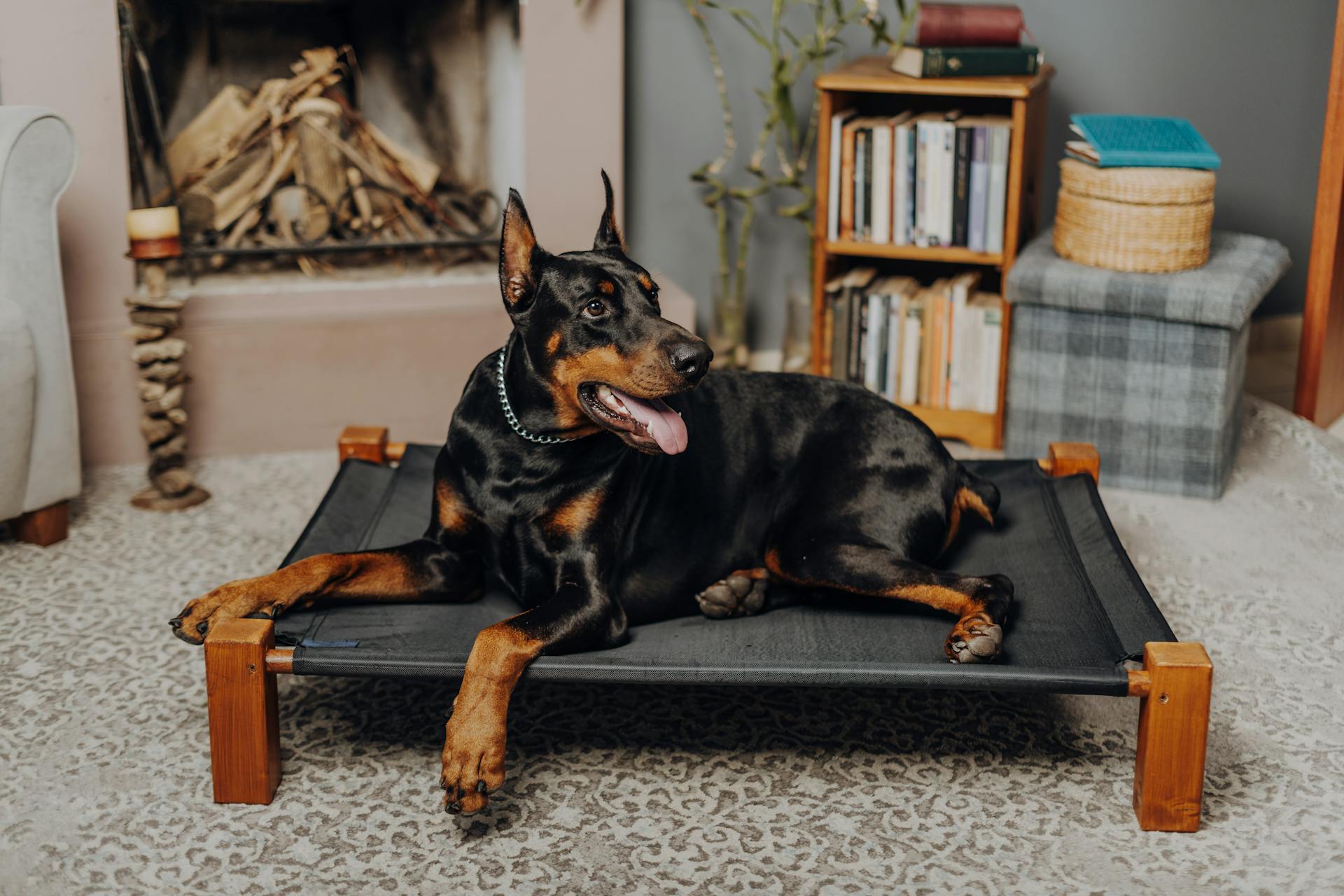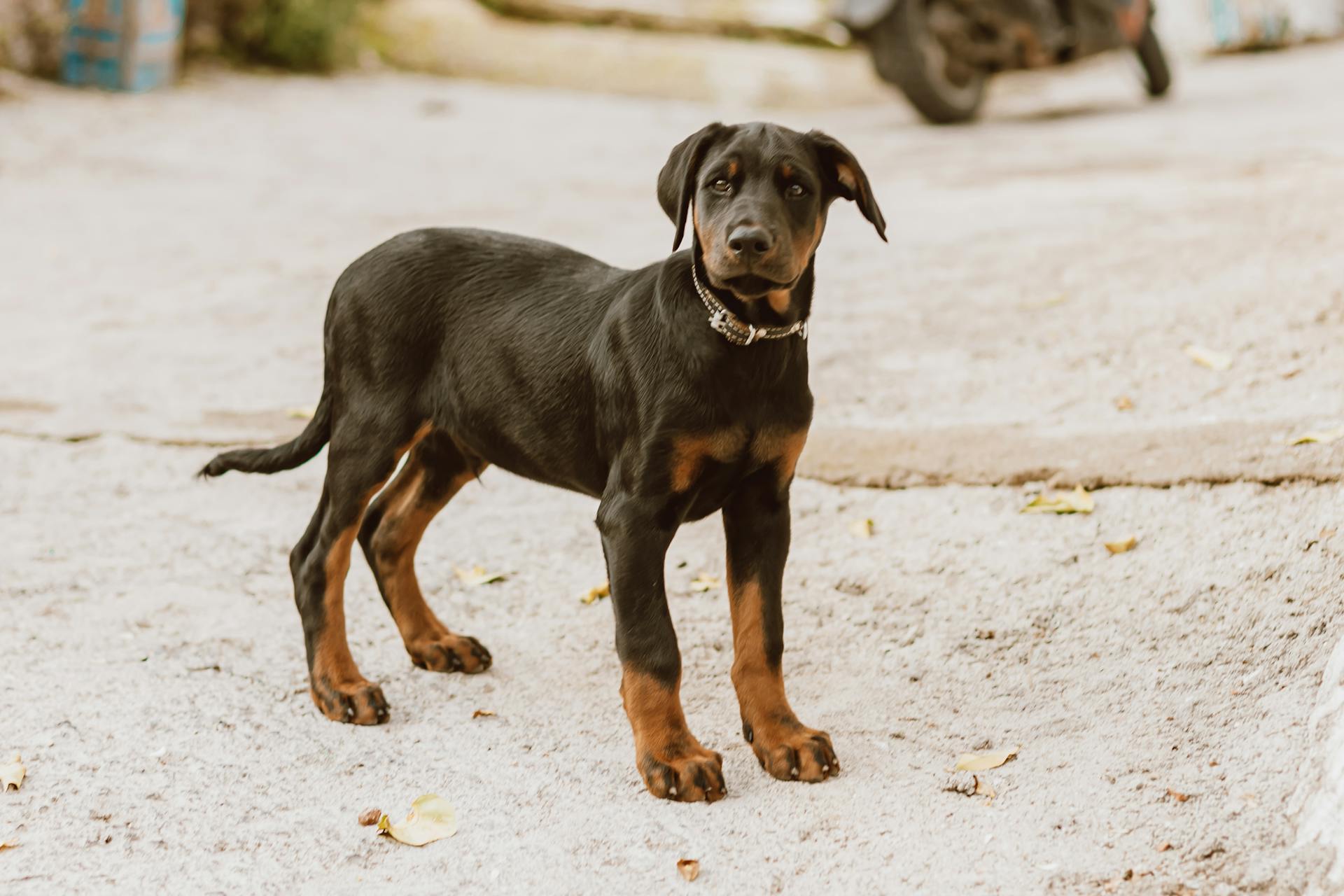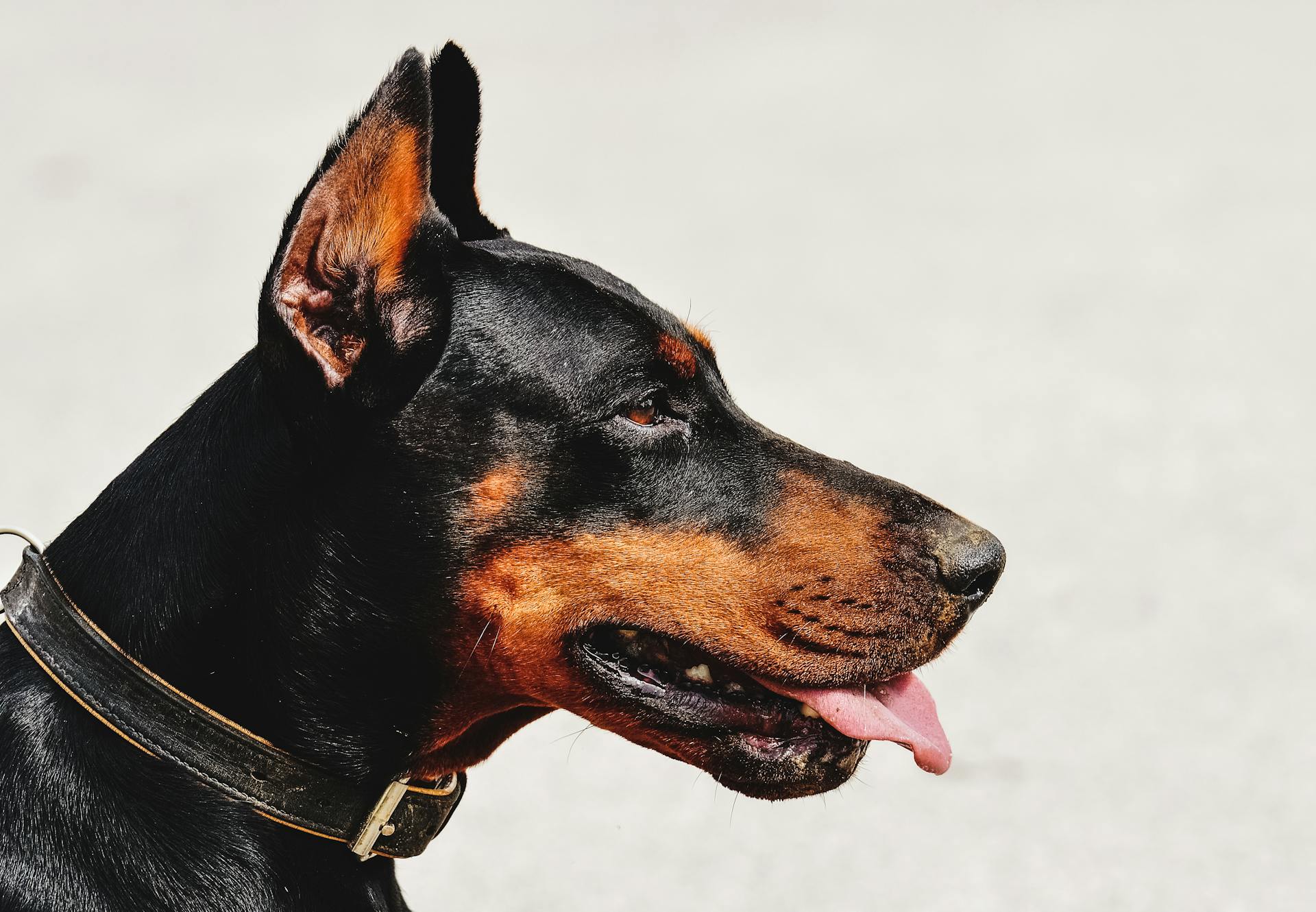
The Doberman Pinscher is a breed of dog known for its sleek appearance and athletic build, weighing between 60-80 pounds on average.
They are often stereotyped as aggressive guard dogs, but this reputation is largely undeserved.
Doberman Pinschers are highly intelligent and trainable, making them popular choices as police and military dogs.
Their short coats require minimal grooming.
You might enjoy: Doberman Pinscher Poodle
Physical Characteristics
Doberman pinschers are a large dog breed that stand more than 2 feet tall.
Female Dobermans usually top out around 26 inches while male pups reach closer to 28 inches in height.
Males can weigh up to 100 pounds but most Dobies fall between 55 to 90 pounds.
Their coats come in black, red, blue, or fawn colors and are almost always solid with splashes of brown over their eyes and on their muzzles, feet, and legs.
Dobies have dark and piercing eyes that are unmistakable.
At birth, a Doberman's ears are relaxed and their tails can grow to about 12 inches in length naturally.
Readers also liked: Black and White Doberman Pinscher
Temperament and Behavior
Doberman Pinschers are highly intelligent and loyal canines that thrive on attention and positive reinforcement training from their family. They require consistency in their schedule and should begin training and socializing when they're still a puppy.
Dobies need to be socialized to other dogs and people, especially since they have a tendency to be protective of their owners. This is why basic obedience training is essential to help them become well-adjusted companions.
Doberman Pinschers are often referred to as "Velcro dogs" because they form a deep bond with their family and want to stick by your side. If left alone for too long, they can develop separation anxiety, so it's crucial to prepare and plan accordingly to prevent this issue.
Famous Guard Dog
The importance of an unflappable temperament for a guard dog cannot be overstated.
Dobermann recognized this when selecting his famous guard dogs, choosing those that were strong, intelligent, and had a steel-like quality to them.
Intelligence was a key trait he looked for, which is why the old German Shepherd Dog was likely used as an influence in creating the breed.
The Rottweiler may have contributed strength and natural guarding ability to the mix.
A good guard dog needs stamina, pluck, and speed, making the German Pinscher another plausible source of these traits.
Scenting ability is crucial for a working dog, which is why the Weimaraner might have been used as an influence.
Temperament
Dobermans are highly intelligent and deeply loyal canines that thrive on attention and positive reinforcement training.
They require a patient owner who will dedicate themselves to their learning, as they need consistency in their schedule.
Basic obedience is excellent to start with, especially for Dobies who are more likely to be protective of their family.
Socialization is key to preventing anxiety or aggression towards strangers and other animals, so it's essential to socialize your Doberman puppy at a young age.
Dobermans can develop separation anxiety if left alone for too long, but kennel training can help them feel secure when you're away.
Kennels should be used as safe spaces where your dog can rest and relax, not as a place for punishment.
Suggestion: Anxiety Quiz
Care and Maintenance
Doberman pinschers are relatively low-maintenance when it comes to their coats, requiring only a weekly brushing and occasional baths.
Their short coats make grooming easy, but they do need regular exercise to stay happy and healthy. A daily walk or run is essential, as well as some playtime in the yard.
Basic care for your Doberman includes brushing their teeth at least twice a week and checking their nails regularly.
Care
Dobermans are relatively low-maintenance when it comes to their coats, requiring only a weekly brushing and an occasional bath.
Their short coats mean they don't need frequent grooming sessions like some other breeds do.
Basic teeth, nail, and ear care is also essential for your Doberman's overall health and well-being.
Daily walks or runs are crucial to keep your Doberman physically active and mentally stimulated.
Regular playtime in the yard or a fenced space can help prevent zoomies, which can be overwhelming for both you and your dog.
Consistent training is vital for Doberman puppies, so consider working with a professional behaviorist or trainer who has experience with this breed.
Dobermans are highly intelligent and love to learn new tricks and commands.
Dog Nutrition
When considering your dog's nutrition, you have several options to explore.
Adding fish oil and omega-3s to their diet can provide essential fatty acids for heart health and inflammation reduction.
Including raw food in a dog's diet has its benefits, such as higher nutrient intake and lower carbohydrate content.
However, it's crucial to transition them gradually to avoid digestive issues.
Oat milk is not recommended as a substitute for regular cow's milk or other dairy products due to its low nutritional value compared to alternatives like fish oil and omega-3s-rich foods.
Curious to learn more? Check out: What to Do with Your Dog's Ashes?
Health and Wellness
Doberman pinschers are known for their robust health, but like every dog breed, they're not immune to certain health issues.
The average Doberman lifespan is 10 to 12 years, which is a great age for a dog.
Hip dysplasia is one of the most common issues Dobies deal with, according to the DPCA. This condition can cause a lot of pain for some dogs.
Readers also liked: Health Certificate
Bloat is another concern for Dobermans - it's a gastrointestinal issue that can occur at any point in a dog's lifetime and carries about a 50% mortality rate.
Doberman owners should educate themselves on the symptoms of bloat and talk to their veterinarian about ways to help prevent it.
Regular health check-ups with your vet every 6 months are essential for identifying potential health issues early.
Some Dobermans may be prone to Wobblers Syndrome, Cardiomyopathy, Albinism, or Hip Dysplasia. These conditions can affect the spine, heart muscle, skin and eyes, or hip joint respectively.
Here's a quick rundown of these conditions:
- Wobblers Syndrome: affects the spine within the neck and results in poor transmission of nerve signals between the brain and the body.
- Cardiomyopathy: is a fatal genetic heart disorder that affects the heart muscle's ability to contract, leading to congestive heart failure or sudden death in adult dogs.
- Albinism: causes a dog to have pink skin and nose and light eyes due to a lack of melanin. Albino dogs are sensitive to sunlight and can suffer from various health problems.
- Hip Dysplasia: is a condition where the thigh bone doesn’t sit right into the hip joint, causing pain for some dogs.
Training and Cost
Training a Doberman Pinscher is essential, and you should start as soon as possible.
You can expect to spend around $50-$100 per month on training classes and equipment, depending on your location and the frequency of sessions.
It's also crucial to remember that this breed requires a significant amount of exercise, both physically and mentally, which may incur additional costs for activities like agility training or dog competitions.
Training Your
Training your dog requires patience and consistency.
Start training your Doberman puppy as soon as you get them, ideally at 10 weeks old, to establish a strong bond and good habits.
Use positive reinforcement techniques like rewarding treats when they behave well, as this breed is eager to please its owners.
Dobermans are very active dogs that need daily exercise, both physically and mentally.
Cost
You're considering bringing a new furry friend into your family, and one of the most important factors is cost. Expect to pay between $1500 to $2500 for a beautiful Doberman Pinscher.
A Dobie being sold under $1000 dollars is very unusual and a red flag. Show quality Dobies are closer to $2500.
Fun Facts and History
The Doberman Pinscher has a rich history and some fascinating facts surrounding its origins and uses.
This breed was developed by Louis Dobermann in the 1880s as a watchdog and guard dog. He mixed different breeds to create a strong, intelligent, and energetic companion that could serve his purposes.
One notable example of the Doberman Pinscher's bravery is Cappie, a war dog who saved the lives of 250 marines by alerting them to the presence of Japanese troops on the island of Guam during World War II. Another war dog, Kurt, became one of the first K-9 casualties on Guam in July 1944.
Dobermans have also made their mark in the world of dog shows, winning best in show at the Westminster Dog Show four times since their recognition by the AKC in 1908.
Here are some notable Doberman Pinschers that have appeared in film and TV:
- Zeus and Apollo, the pair of Dobies owned by the titular "Magnum P.I."
- Alpha in the Pixar film "Up",
- Diablo (voiced by Edward James Olmos) in "Beverly Hills Chihuahua."
Despite their name and similarities, the miniature pinscher is not a mini Doberman Pinscher – the two breeds actually aren't related at all.
History
The Doberman pinscher has a fascinating history that dates back to the 1880s with Louis Dobermann, a tax collector and breeder from Apolda, Germany.
Louis Dobermann wanted to create a new breed that would serve as excellent watchdogs, which he achieved by mixing different dog breeds together. He chose two German breeds, the old German shepherd and the German pinscher, to create a unique combination of strength, stamina, and intelligence.
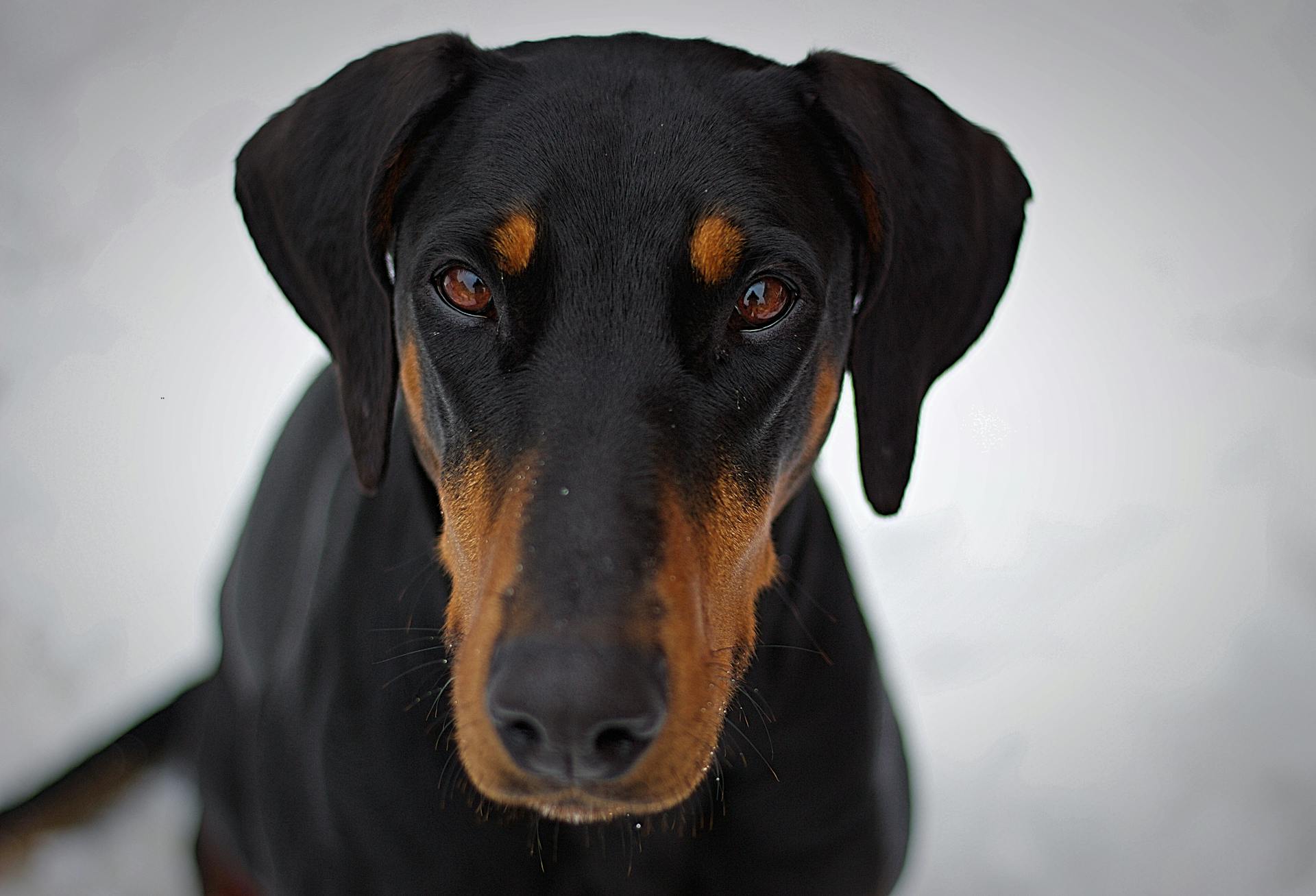
The exact breeds used by Dobermann are unknown, but it's believed they played a major role in creating the ancestors of other popular breeds like the Rottweiler and Weimaraner. These two dogs were crucial in shaping the foundation of the Doberman pinscher breed.
Dobermans have a long history as military and police dogs, with their popularity peaking in the first half of the 20th century. They were eventually replaced by other breeds like German shepherds, Belgian Malinois, or Dutch shepherds for these roles.
In recognition of his contributions to the breed, Germany named the Doberman pinscher after Louis Dobermann upon his death in 1894. The name was later shortened to simply "Dobermann" in the 1940s, but North America still refers to it as the "Doberman pinscher."
Fun Facts
The Doberman Pinscher is an incredible breed with a rich history and impressive accomplishments. They were adopted by the United States Marine Corps as their official war dog in World War II and served extensively in both the European and Pacific theaters of operation.
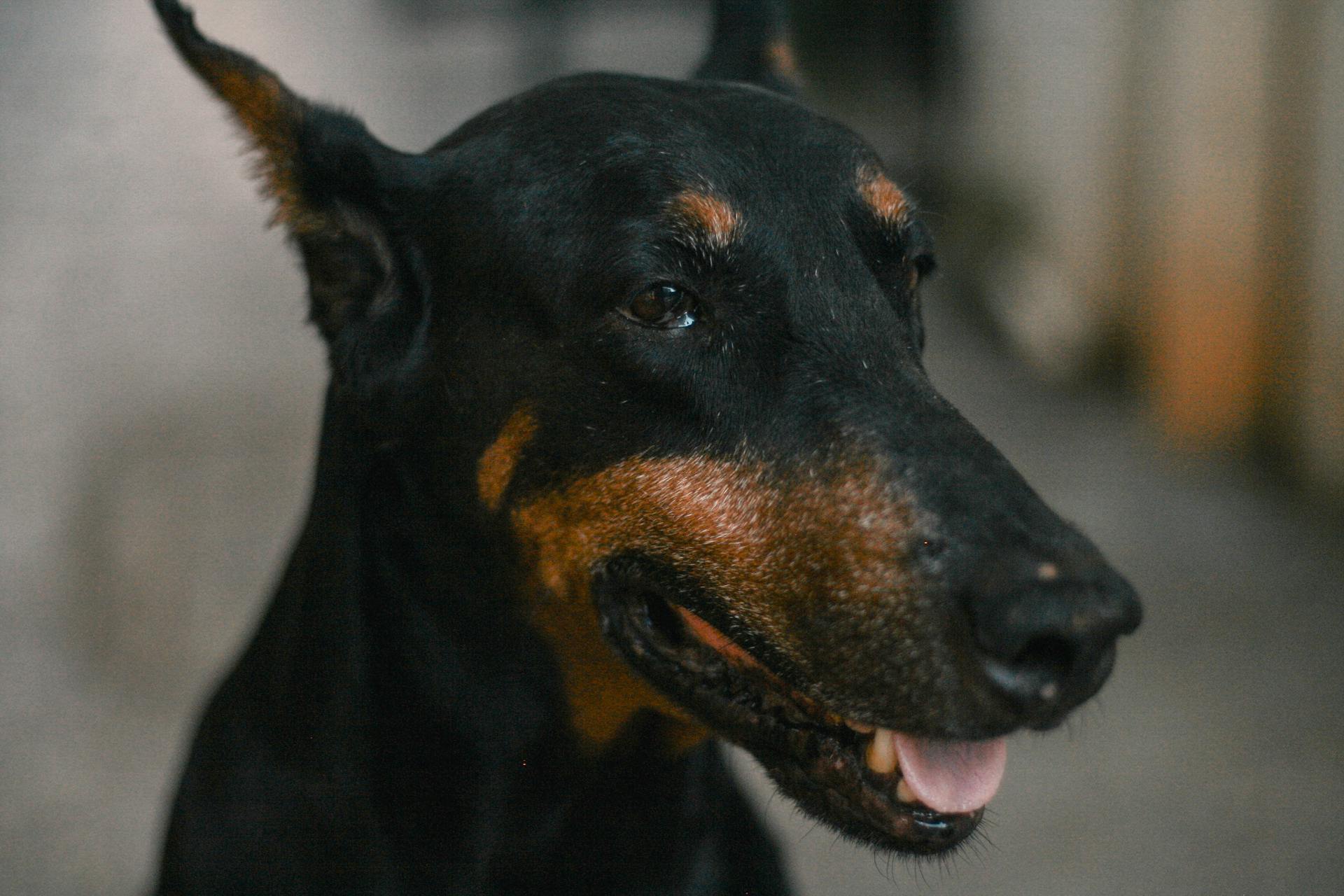
One remarkable example of a Doberman's bravery is Cappie, who saved the lives of 250 marines by alerting them to the presence of Japanese troops on the island of Guam. This heroic act showcases the breed's loyalty and protective instincts.
Dobermans have also made their mark in the world of dog shows, winning best in show at the Westminster Dog Show four times since their recognition by the AKC in 1908. Ch. Rancho Dobe's Storm even took home back-to-back wins in 1952 and 1953.
You might be surprised to learn that Dobermans have appeared in various films and TV shows, including "Magnum P.I." with Zeus and Apollo, as well as the Pixar film "Up" featuring Alpha.
Intriguing read: Dobermans Good Apartment Dogs
Frequently Asked Questions
Why are Dobermans so special?
Dobermans are special due to their exceptional courage, intelligence, and loyalty. These traits made them a popular choice for police and military work, as well as beloved companions in homes worldwide.
What are the cons of Doberman Pinscher?
Doberman Pinschers are prone to health issues such as cardiovascular problems, hip dysplasia, and blood clotting disorders. Responsible ownership requires careful consideration of these potential drawbacks.
What breeds make up the Doberman?
Q: What breeds are part of the Doberman's ancestry? A: The Doberman is believed to be a cross between several breeds, including Rottweiler, German Pinscher, Great Dane, and others.
Is a Doberman a good family dog?
A Doberman can make a good family pet if socialized early, but they often form strong bonds with one person in the household. With proper training and care, they can be loyal and loving companions for families.
What is the lifespan of a male Doberman?
A male Doberman's average lifespan is 10-12 years. Regular care and monitoring can help prevent or manage potential health issues that may affect this breed.
Sources
- https://www.akc.org/expert-advice/dog-breeds/doberman-pinscher-history/
- https://www.pethealthnetwork.com/dog-health/dog-breeds/doberman-pinscher
- https://www.dailypaws.com/dogs-puppies/dog-breeds/doberman-pinscher
- https://www.servicedogtrainingschool.org/blog/doberman-pinscher-service-dog
- https://moderndogmagazine.com/articles/breeds/the-doberman-pinscher/
Featured Images: pexels.com
